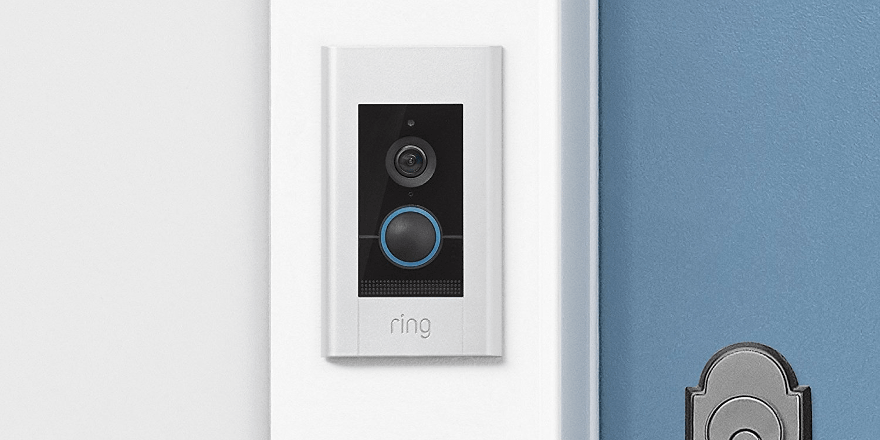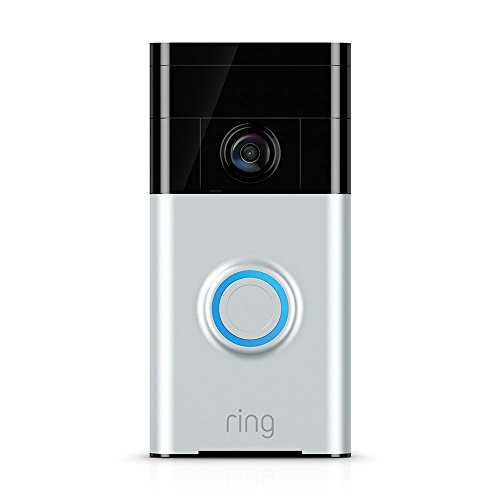Both the DoorBird and Ring represent some of the best quality on the market when it comes to video doorbells. When comparing DoorBird vs. Ring, it can be difficult to declare a clear winner as they are best suited for different needs.
DoorBird is a professional-grade doorbell with a slew of features and attractively priced plans. Ring, on the other hand, continues to be one of the most popular doorbells on the market due to its solid performance and the support of a robust lineup of accessories and compatible devices.
Let’s dive into what makes each doorbell great to help you get a sense of which one might be right for you.
About DoorBird and Ring
DoorBird combines attractive design with innovative IP technology that gives you complete control over your home’s entrance. The company offers a suite of smart camera products — their primary product being the DoorBird WiFi Doorbell, which provides a method of monitoring and answering your door from anywhere in the world and is built of sturdy, high-quality materials. The company also offers the DoorBird IP Video Door Station and BirdGuard camera as alternative methods of keeping your home protected.
No products found.
The Ring product line is perhaps one of the most widely-recognized line of smart doorbells — and for good reason. Their lineup consists of products that range from a basic model that combines quality and affordability, all the way up to the Video Doorbell Elite which provides professional-level monitoring to your home.
Which device is right for you and your home depends on what you’re looking for, but both companies are industry leaders with a track record of creating excellent doorbells that add both security and convenience to your home.
DoorBird vs. Ring — Things in Common
There are a number of ways in which these products stand out from one another, but the DoorBird and Ring are similar in a lot of ways — each checking all the boxes when it comes to the basics of keeping your home protected.
Both the DoorBird and Ring record in 720p HD, giving you a high-quality feed of the front of your home and the ability to discern key features about those who walk up to your home. The HD quality should add a lot of peace of mind, as it allows homeowners to receive a solid picture of would-be intruders and friendly visitors alike.
The DoorBird and Ring also both feature support for night-vision and audio, allowing you to keep stock of the front of your home even when it’s dark as well as to converse with anyone who walks up to your home.
DoorBird vs. Ring — Differences

-
Difference #1: Field of View – Field of View is an important specification to keep in mind, as it is the main determiner of how much of the front of your home your video doorbell will be able to monitor. The DoorBird and Ring both have an identical horizontal field of view at 180 degrees, but the DoorBird falls behind in vertical capabilities as it monitors 90 degrees vs. the 140 degrees we see with Ring.
Ultimately, both smart doorbells will give you a good view of a wide area, but in a top-to-bottom view the Ring doorbell definitely pulls ahead.
-
Difference #2: Power Supply – Knowing how your doorbell will be powered before you make a purchase can help save a lot of hassle, as some models wire directly into your home while others function on battery. Having an idea of the exact installation process you’ll need to prepare for before buying the DoorBird or Ring will help ensure that you aren’t in for any unpleasant surprises when it comes time to hook everything up.
The primary way in which most people will power their DoorBird is through a traditional hardware setup, but the doorbell also supports a technology called Power Over Ethernet. To put it simply, this power method allows the Ethernet cord that delivers internet access to your device to play double duty as the primary power source as well. This is an excellent option for those without an existing doorbell setup or who would like to avoid the sometimes-frustrating installation process.
The Ring doorbell runs either off of a battery or with an existing hardwired doorbell kit, although the Ring Elite Doorbell — the company’s high-end model — does support Power over Ethernet as well.
-
Difference #3: Live View On Demand – One of the primary ways in which the DoorBird sets itself apart from the Ring doorbell is in its access to Live View On Demand. Being able to access a video feed of the front of your home from nearly anywhere is a major aspect of what makes the DoorBird so great.
The Ring doorbell has Live View On Demand as well, albeit with a much more limited scope. In order to access the feature, you’ll need to have installed the device via a hardwired connection due to the large amount of power it requires to function.
-
Difference #4: Cloud Recording – While purchasing the DoorBird or Ring provides some excellent coverage by default, they are both enhanced by cloud storage and recording, and differ in the way that they offer these services to their customers.
DoorBird offers free storage for the 20 most recent visitor and motion events. If you’re just looking for a recap of the most recent activity outside of your door, this free plan should be more than enough to suit your needs. If you need access to wider storage, such as when you find yourself away from home for longer periods of time, you can either purchase a DoorBird Video Door Station for additional storage or invest in Cloud-Recording Pro.
DoorBird Pro includes support for:
- Unlimited number of Doorbell event recordings
- Unlimited Motion Sensor recordings
- View and download event recordings
- A Convenient search filter to locate relevant footage
- Storage for recordings for up to 7 days
Price: $48/yr
The Ring doorbell without any subscription plans will only send alerts to your smartphone and/or email and will not record any video. This is certainly a detractor from the doorbell’s utility, but there are fortunately some attractively priced subscription plans that add a number of useful features without breaking the bank.
There are two main subscription plans: Protect Basic and Protect Plus.
Protect Basic includes support for:
- Video storage for up to 60 days
- Video review at any time when you miss an alert
- Sharing for videos with friends, family, or law enforcement
Price: $3/mo or $30/yr
Protect Plus includes all of the features in Protect Basic, as well as:
- Support for unlimited Ring Cameras
- 10% off purchases at Ring.com
- Extended Warranty
- 24/7 Professional Monitoring
Price: $10/mo or $100/yr
-
Difference #5: Colors – The DoorBird and Ring are both available in multiple finishes, although the Ring comes in four different colors while the DoorBird only comes in two color schemes.
Although it may have fewer coloring options, the DoorBird comes in a beautiful stainless steel finish that will fit in with any aesthetic. There is also an option for a white polycarbonate finish on certain models for those looking for something a little bit different.
The Ring doorbell has more customizability, and is available in Venetian Bronze, Polished Brass, Antique Brass, and Satin Nickel — making it a near-guarantee you’ll be able to find an option that integrates seamlessly with your home.
DoorBird vs. Ring — Comparison Chart
| DoorBird | Ring | |
|---|---|---|
| Video Resolution | 720p HD | 720p HD |
| Field of View | 180° horizontal, 90° vertical | 180° horizontal, 140° vertical |
| Power supply | Hardwired or Power over Ethernet | Battery or Hardwired to Existing Doorbell Kit |
| Battery Life | N/A | 6-12 months |
| Compatible Doorbell Transformers | 15 V DC (power 110 - 240 VA C) |
8-24 V AC, DC not compatible |
| Compatible Networks | 2.4 GHz 802.11 b/g/n or Ethernet network, with DHCP | 2.4 GHz 802.11 b/g/n |
| Live View On Demand | Yes | Only if Wired |
| Night Vision | Yes | Yes |
| Two-Way Audio | Yes | Yes |
| Cloud Recording | With Local NAS/NVR or Subscription | With Subscription |
| Operating Temperature | -4 to 104°F (-20 to +40°C) | -5 – 120°F (-20 – 50°C) |
| Size | 6.18 x 2.95 x 1.38 in 15.7 x 7.5 x 3.5 cm |
4.98 x 2.43 x 0.87 in 12.65 x 6.17 x 2.21 cm |
| Colors | Available in two finishes | Available in four finishes |
| Price | $$$ | $$$ |
DoorBird and Ring’s Accessories

The DoorBird and Ring doorbells are excellent products on their own, but there are optional add ons that add more convenience or functionality to your new device.
DoorBird has just a few simple options, with a door chime to allow you to hear the bell without hardwiring to the original setup as well as a Power Over Ethernet adapter in order to let you take advantage of more convenient powering options.
The Ring product family is a little bit more fleshed out, and there are a number of options you can take advantage of in order to make sure your Ring doorbell works just the way you intend.
The Ring Chime functions similarly to the DoorBird model, allowing for more flexibility in the way you power and hook up the bell. The Ring Chime Pro takes the Chime to the next level, functioning as a WiFi extender so you can receive coverage all around your property.
For those of us using the battery-powered Ring, a Solar Charger can help ensure that we don’t have to swap out power packs too often, and the corner and wedge kits offer an unprecedented flexibility when it comes to installing your Ring doorbell in the perfect spot and at the perfect angle.
DoorBird vs. Ring — Our Thoughts

When comparing the DoorBird vs. Ring, it’s difficult to declare a clear winner as both devices excel in different areas.
The DoorBird is a more expensive option than the Ring, and offers a high-end construction that is both beautiful and utilitarian. The free cloud recording allows homeowners access to recent video footage without any additional cost, and the Pro membership which offers far more utility is attractively priced. Live View On Demand and Power Over Ethernet support round out an extremely competitive video doorbell.
The Ring doorbell is the more affordable option, but that doesn’t mean that it skimps on features. With a wider field of view, more customizability with colors, support for battery power with solar charging, and two tiers of accessible subscription plans, it continues to be one of the top smart doorbells on the market.
All in all, if you’re looking for a high-end device and are willing to pay a premium for it, the DoorBird may be your best bet. For a combination of affordability and quality, however, the Ring family just can’t be beat.
Last update on 2024-04-19 at 22:59 / Affiliate links / Images from Amazon Product Advertising API






